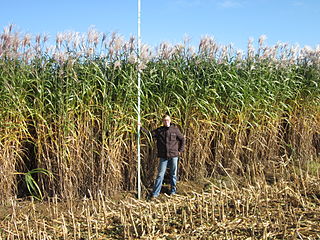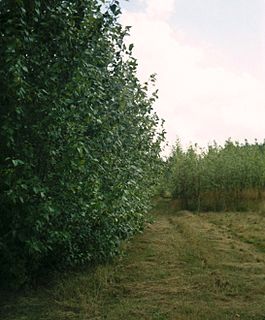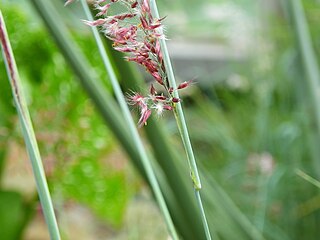
Biofuel is fuel that is produced through contemporary processes from biomass, rather than by the very slow geological processes involved in the formation of fossil fuels, such as oil. Since biomass technically can be used as a fuel directly, some people use the terms biomass and biofuel interchangeably. More often than not, however, the word biomass simply denotes the biological raw material the fuel is made of, or some form of thermally/chemically altered solid end product, like torrefied pellets or briquettes.
Pampas grass or pampas-grass is a common name which may refer to any of several similar-looking, tall-growing species of grass:
Cellulosic ethanol is ethanol produced from cellulose rather than from the plant's seeds or fruit. It is a biofuel produced from grasses, wood, algae, or other plants. The fibrous parts of the plants are mostly inedible to animals, including humans, except for Ruminants and animals that rely on Hindgut fermentation.

Ornamental grasses are grasses grown as ornamental plants. Ornamental grasses are popular in many colder hardiness zones for their resilience to cold temperatures and aesthetic value throughout fall and winter seasons.

Bioenergy is energy made from biomass or biofuel. Biomass is any organic material which has absorbed sunlight and stored it in the form of chemical energy. Examples are wood, energy crops and waste from forests, yards, or farms. Since biomass technically can be used as a fuel directly, some people use the terms biomass and biofuel interchangeably. More often than not, however, the word biomass simply denotes the biological raw material the fuel is made of, or some form of thermally/chemically altered solid end product, like torrefied pellets or briquettes. The word biofuel is usually reserved for liquid or gaseous fuels, used for transportation. The U.S. Energy Information Administration (EIA) follows this naming practice.
Biomass to liquid is a multi-step process of producing synthetic hydrocarbon fuels made from biomass via a thermochemical route.

Miscanthus, or silvergrass, is a genus of African, Eurasian, and Pacific Island plants in the grass family.
Lignocellulose refers to plant dry matter (biomass), so called lignocellulosic biomass. It is the most abundantly available raw material on the Earth for the production of biofuels, mainly bio-ethanol. It is composed of carbohydrate polymers, and an aromatic polymer (lignin). These carbohydrate polymers contain different sugar monomers and they are tightly bound to lignin. Lignocellulosic biomass can be broadly classified into virgin biomass, waste biomass and energy crops. Virgin biomass includes all naturally occurring terrestrial plants such as trees, bushes and grass. Waste biomass is produced as a low value byproduct of various industrial sectors such as agriculture and forestry. Energy crops are crops with high yield of lignocellulosic biomass produced to serve as a raw material for production of second generation biofuel; examples include switchgrass and Elephant grass.

Energy crops are low-cost and low-maintenance crops grown solely for energy production by combustion. The crops are processed into solid, liquid or gaseous fuels, such as pellets, bioethanol or biogas. The fuels are burned to generate electrical power or heat.

Miscanthus sinensis, the eulalia or Chinese silver grass, is a species of flowering plant in the grass family Poaceae, native to eastern Asia throughout most of China, Japan, Taiwan and Korea. It is an herbaceous perennial grass, growing to 0.8–2 m (3–7 ft) tall, rarely 4 m (13 ft), forming dense clumps from an underground rhizome. The leaves are 18–75 cm (7–30 in) tall and 0.3–2 cm broad. The flowers are purplish, held above the foliage. This plant is the preferred structure for the nesting of some species of paper wasps, such as Ropalidia fasciata.
The term Elephant grass may refer to the following grass species:

Biomass is plant or animal material used as fuel to produce electricity or heat. Examples are wood, energy crops and waste from forests, yards, or farms. Since biomass technically can be used as a fuel directly, some people use the terms biomass and biofuel interchangeably. More often than not, however, the word biomass simply denotes the biological raw material the fuel is made of, or some form of thermally/chemically altered solid end product, like torrefied pellets or briquettes.

Miscanthus × giganteus, the giant miscanthus, is a sterile hybrid of Miscanthus sinensis and Miscanthus sacchariflorus. It is a perennial grass with bamboo-like stems that can grow to heights of more than 4 metres (13 ft) in one season. Just like Pennisetum purpureum, Arundo donax and Saccharum ravennae, it is also called elephant grass.

Short rotation coppice (SRC) is coppice grown as an energy crop. This woody solid biomass can be used in applications such as district heating, electric power generating stations, alone or in combination with other fuels. Currently, the leading countries in area planted for energy generation are Sweden and the UK.

Imperata is a small but widespread genus of tropical and subtropical grasses, commonly known as satintails.
Eriochrysis is a genus of African and Neotropical plants in the grass family.

Tricholaena is a genus of Asian, African, and Italian plants in the grass family.

Miscanthus floridulus, the Pacific Island silvergrass, is a species of perennial grass in the family Poaceae.
Herbaspirillum frisingense is a nitrogen-fixing bacterium which was found in C4-fibre plants like prairie cordgrass, Chinese silver grass,, Amur silver-grass, and Napier grass. The specific name frisingense comes from Freising, a town in Germany where H. frisingense was first isolated from prairie cordgrass and Miscanthus plants.

Elean power station is a straw-fired biomass power station in Cambridgeshire, England. At a capacity of 38 MW, it was the largest straw-fired power plant in the world at the time of its completion. The power station was constructed between 1998 and 2000 by FLS Miljo and is operated by EPR Ely Ltd. It generates 270 GWh of electricity from 200,000 tonnes of biomass annually, supplied by Anglian Straw Ltd. Straw is the major fuel of the plant, but oilseed rape and the energy crop Miscanthus are also used, as well as some natural gas.












